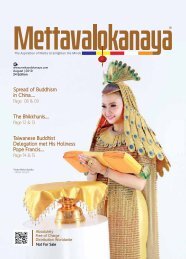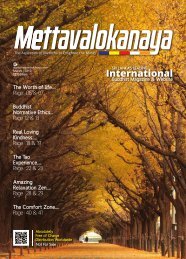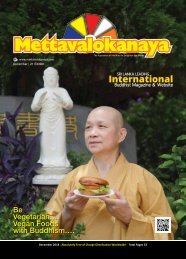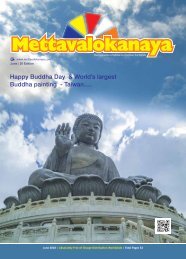#Mettavalokanaya_International_Buddhist_Magazine_November_2021
This is the World’s Most Popular & Leading Monthly International Buddhist Magazine, “Mettavalokanaya” on November 2021 Edition - 33.
This is the World’s Most Popular & Leading Monthly International Buddhist Magazine, “Mettavalokanaya” on November 2021 Edition - 33.
You also want an ePaper? Increase the reach of your titles
YUMPU automatically turns print PDFs into web optimized ePapers that Google loves.
Developing
Loving
Kindness….
Most Venerable Pannyavaro Maha Thera
Resident Teacher, Founder and Abbot
of Bodhi Tree Forest Monastery and
Community Retreat Centre in Northern
New South Wales, Australia.
“Real Loving
Kindness”….
Four types of people are chosen
to develop loving-kindness
towards: First: a respected,
beloved person, such as a
teacher or mentor (kalyana mitta);
Second: a dearly beloved person,
that is a close family member or
dear friend; Third: a neutral person,
somebody you know but have no
emotional involvement with; Fourth:
a hostile person, that is, a person you
are currently having difficulty with.
Starting with yourself, then
moving systematically from person
to person in the above order, the
objective is to break down the barriers
between the four types of people and
yourself. In this way, it can be said
to break down the divisions within
one’s own mind, the source of much
of the conflict we experience in our
relationships.
The key to the practice is being
able to go beyond the barriers we
create in the mind, for the Buddha
describes the loving person as having
‘a mind with the barriers broken down’.
When a person has seen, and seen
through the conceptually created
barriers of gender, race, class, and
‘mine’ and ‘not mine’ they are able to
love others unconditionally.
The effect of practising
systematic loving-kindness
meditation is that one is transforming
the particular love one naturally has
for one’s close family members and
dear friends— which is actually an
attached kind of love— to a more
general, universal love that embraces
everybody without exception, that is,
altruistic love. Just a word of caution.
If you practice loving-kindness
intensively, it is best to choose a
member of the same sex, or if you
have a sexual bias to your own sex
then a person of the opposite sex.
This avoids the risk of arousing the
near enemy of lovingkindness, that is,
lust. Try different people to practise
on, as some people do not easily fit
into the above categories, but do keep
to the prescribed order.
Three ways to arouse feelings
of loving-kindness: Visualisation—
create a vivid positive mental picture
of oneself and the four people one
has chosen, in order to promote a
sense of loving-feeling, well-being
and joyousness. Reflection— think
about the positive qualities of the
person and the acts of kindness they
have done, or make an affirmation,
which is a positive statement about
yourself, in your own words.
The exception to using the
‘reflection device’ is when working
with the ‘difficult person’ because the
thinking might trigger the painful
relationship and aggravate things.
So just a visualisation of the difficult
person, reinforced by the auditory
repetition is sufficient. Auditory— This
is the simplest but probably the most
effective way. Repeat an internalised
phrase such as ‘loving-kindness’,
‘loving-kindness’. The visualisations,
reflections and the repetition of
lovingkindness are devices to help you
arouse positive emotional feelings of
love. You can use all of them or one
that works the best for you. When
the positive emotional feeling arises,
switch from
the devices to the feeling, as it is
the feeling that is the primary focus.
Keep the mind fixed on the feeling,
if it strays, bring it back to the device
or if the feeling weakens or is lost
then return to the device, for example,
use the visualisation to bring back
or strengthen the feeling of lovingkindness.
The next stage is Directional
Pervasion, where one systematically
projects the aroused feeling of lovingkindness
to all points of the compass:
north, south, east and west, up and
down, and all around.
Bringing to mind Dhamma
friends and communities in the cities,
towns and countries around the
world can enhance the directional
pervasion. The last stage, Non-specific
Pervasion, tends to spontaneously
occur as the practice matures. It is
not discriminating. It has no specific
object and involves just naturally
radiating feelings of universal love.
When it arises, the practice
has come to maturity in that it has
changed preferential love, which is
an attached love, to an all-embracing,
unconditional love! When the mind
has been uplifted and is sweet with
feelings of loving-kindness, you will
find that the drier vipassana practice
is very much easier— the meditator is
in a heightened state of receptivity
and able to tune in more sensitively
to what is happening in the present
moment.
| NOT FOR SALE |
8 l Mettavalokanaya l November l 2021 2021 l November l Mettavalokanaya l 9
















